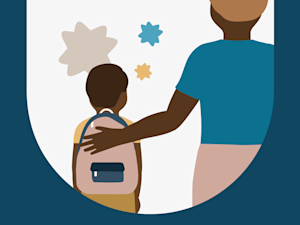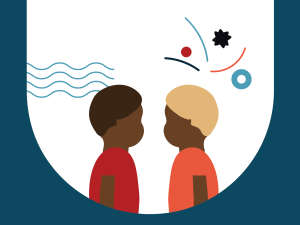Stay in the know
All our latest podcasts delivered right to your inbox.
While the holiday season can be exciting, it can also stimulate the senses in a way that makes it less fun for some kids. For kids with sensory processing challenges, the holidays can be overwhelming.
In this episode, hosts Gretchen Vierstra and Rachel Bozek welcome returning guest Keri Wilmot. Keri, a pediatric occupational therapist, shares some of the ways the holidays can bring on sensory overload. From costumes to new foods and more, Keri has strategies to help you and your child enjoy the holidays.
Related resources
Plus, check out Wunder to get expert support around sensory processing challenges and connect with other parents.
Episode transcript
Gretchen: From the Understood Podcast Network, this is "In It," a podcast about the ins and outs...
Rachel: the ups and downs...
Gretchen: of supporting kids who learn and think differently. I'm Gretchen Vierstra, a former classroom teacher and an editor here at Understood.
Rachel: And I'm Rachel Bozek, a writer and editor with a family that's definitely in it. Today, we're talking about how the holidays can rattle the senses.
Gretchen: Whether it's a beloved but scratchy Halloween costume,
Rachel: or the loud and crowded gatherings that come at the end of the year,
Gretchen: holidays can be a real challenge for kids who have sensory sensitivities.
Rachel: So, what can we do to make this sensory overwhelm a little easier? For some excellent tips, we've invited Keri Wilmot to join us.
Gretchen: Keri is a pediatric occupational therapist based in Texas, who we had on the podcast once before to talk about quote-unquote picky eaters.
Rachel: Yeah, you know, that episode was before I was part of the show, but I listened to it and it was super helpful. So, Keri also leads a group over on Wunder, Understood's free community app for parents of kids with learning and thinking differences. And we're so glad she's here with us today.
Gretchen: Keri, welcome back to the podcast!
Keri: Thanks, Gretchen.
Gretchen: So, today, as you know, we're talking about some of the challenges that can come up for kids who have sensory challenges. For some context, though, I was wondering if you could tell us if this is something that comes up for you in your practice as a pediatric occupational therapist. Do you see a lot of anxiety around things like Halloween, Thanksgiving, and all the holidays that come up at the end of the year?
Keri: I do. I think as the holidays come closer, you know, especially now that everybody's getting back together in person and we have lots of events. You know, there's trick or treats, family dinners, school orchestras, you know, holiday parties. There's work parties. You know, so I find that there's generally a lot of stress around events. And so, yeah, definitely it is something that I think parents are stressed about.
Rachel: So, Keri, we thought it might be useful to break this conversation down by looking at one sense at a time. So, that would mean vision, hearing, touch, smell and taste. So, let's start with one that I don't think people automatically consider first, which would be the sense of smell. What with pumpkin spice everything, scented candles, lots of cooking going on, it seems like there might be some extra triggers during the holidays. What's your experience with that kind of thing?
Keri: Yeah, there's lots of different smells, like I think that's kind of the hard part for a lot of kids. They're used to like, maybe one or two smells at a regular family dinner, right? And then you walk into an event, or you're at a family party and there's a whole buffet out there of just so many different things. And so, for kids that I know that have struggled with this, it almost hits them like a brick wall.
Rachel: Yeah.
Keri: It really shocks them to their core and they're not quiet about it. Even my son will do that. He'll be like, "This smells terrible," you know?
Rachel: Right.
Keri: And that's like maybe even a nice way to put it, because they're usually like, "Ugh, phew!" So, that is the hard part with smell. Like, is it just, you don't know it's coming, you know? But one of the recommendations that you can usually try to do, and I think a lot of what I'll kind of recommend today is more about that preparation ahead of time. You know, there's always going to be these things with sensory kids that come out of nowhere that you couldn't really predict. But if you think about the whole experience in general, there are some activities and things that you can practice through and problem solve through so that you at least maybe have a strategy in place to try when you get there.
So, you know, for smell, a lot of times that might be at home just talking about smell, and going around the house and finding things to smell: different candles, different foods, different shampoos, different lotions, you know, and really just getting a sense of the kinds of smells that your child likes and dislikes. But what's really neat now is they make a lot of scented slimes and pencils. Somebody told me the other day, which I think is a terrible idea, they have scented scissors, you know?
Rachel: Oh, no! Why?
Keri: I have no idea. That just sounds awful. You know, but for kids, I think it's important to kind of bring something like that. If there's a way to do that in a certain situation, like if it's a family party, find a scent they like in a form that they enjoy, like, you know, scented slime is perfect because it offers that tactile sensory component that helps kids calm down and they can have that scent that maybe replaces the scent that they don't like.
Gretchen: I've done that. I've put lavender on my wrists to smell when there's a scent that I don't like. I'm very scent-sensitive, so I get it.
Rachel: What about vision? This is another one that I think we don't think about a whole lot.
Keri: Yeah, for sure. Again, back to those events. I think when there's a lot of people in the room that are moving about, that is a lot of visual information to process. Same kind of thing like, you know, if you're having a party in the house and there's just decorations all over the place, right? All over the walls, all over the tables, you know, Halloween, you've got these bright orange tablecloths. There's just a lot of different things to look at. And that in itself can be enough for them to just get a little bit overstimulated, not knowing where to look, not knowing where to go, where do I find things? Lots of competing backgrounds. So, just like we might do the same thing in a classroom, I would, you know, say to a teacher, "Hey, we should be mindful of all the information that's going on in here." It would be the same thing at a party. I'm not saying don't have decorations, you know, but just be mindful of kind of where they're placed. Maybe have a space that isn't decorated as much for kids to gravitate towards where they can have a place to calm down and chill out.
And then there's the food, right? Like, why does holiday food look so different? It does! I mean, there's kids that, like, you could make chicken the same way, but it's a holiday meal and you're going to add parsley as a garnish, and all of a sudden it's like a game changer. Like, "What is that green speck?" And so...
Rachel: Right.
Gretchen: Or marshmallows on top of things.
Keri: Yeah, exactly. We have these garnishes and these seasonings and, you know, and kids are just really that one little piece they hone in on to, it looks different and they're like, "No way." And I think in the food realm, a lot of people think it automatically is like a tactile taste thing. Like, you know, they don't want to eat it. And it's really sometimes that they just take one look at it and they can't even get beyond the visual piece, never mind get to the actual touching or eating part. They're so turned off by that. And so, I encourage a lot of parents to like when you present kids with food, like really look or an experience, right? Maybe it's those ooey gooey eyeball pasta things that you do at Halloween, you know, like when you present something to them, watch. What's their body language telling you? And so that's something to kind of keep in mind if that visual sense just gets really overwhelmed.
So, one way around that is to kind of, again, like practice. You know, for foods, I'll often tell parents "Practice letting them tolerate something sit on their plate." There is no expectation to eat it. There is no expectation to touch it. You can just keep it, even if it has to be on a separate plate next to your plate. Keep it in a place where you can get comfortable looking at it and then when you're done, throw it away. Sometimes it's really just, that's the first step.
Gretchen: I really like your tip about when it comes to sights of maybe having a decoration-free room. I feel like it would be good for anybody. It's like a deprivation chamber.
Keri: Yeah.
Gretchen: You get to go in the room without all the little tchotchkes around and everything and just be like, "Ahhh."
Keri: Yeah, I think that should just be a party thing in general, right? Because a lot of the strategies that I have, kids that have sensory issues, they're seeking control, but then they get overwhelmed, you know? And no matter where they go, having a safe space anywhere is really key so that you can redirect them to that room or that space or that place or that, you know, just outside the auditorium or a quiet area where they can have a few minutes. Ideally, if it can be near where the major part of the party is, great! If it has to be in the room a little further away, no problem. You know, you want to prevent that feeling that you have to get in the car and go, right? Like, that you can't go at all.
Rachel: Yeah.
Keri: That's the struggle for a lot of families that they tell me is "It's a lot of work to get there, and then I'm going to get there, and then I'm going to have to leave in like 5 minutes. And so, we'll just not go."
Gretchen: Right.
Keri: But it's so important, I think, for kids to have those experiences. But again, it's the preparation and the planning ahead of like, "How can we make this as successful as possible? Knowing yeah, maybe the end result is we're going to have to leave, but maybe we only have to leave in 30 minutes instead of like right away.
Gretchen: I want to talk a little bit about our sense of touch. And you kind of brought this up with the gooey stuff that goes on at Halloween sometimes. And for me personally, I love Halloween, and I love all things like that, like fun little haunted house stuff and, you know, touch this random thing, and... But I imagine that there's so many triggers for kids at Halloween, and touch is probably one of them. But then there's other things as well. So, can you talk a little bit about how we might help kids prepare or get through Halloween?
Keri: So, in terms of dealing with those tactile issues, I have some really good strategies, right? These are those times where you're making something that has like ingredients. You have to mix with your hands and get all kind of messy. It could be those really fun Halloween ooey, gooey experiments, and that would be like gloves, like just find some like household cleaner gloves or just regular disposable ones. And I think it's OK for kids to know like, you know, "Hey, we can wear gloves and we can still have this experience."
Gretchen: That's great. Carving a pumpkin I, ugh, I can't get in there with my hands.
Rachel: Pumpkin guts are not your thing?
Gretchen: No! So, I use a spoon, big spoon, and now I think I'm going to get a pair of gloves.
Keri: Lots of kids like to have a little bit of distance between what they're touching and how they're participating in the activities. So, you know, maybe they don't want to get their hands in like the spaghetti for Halloween, but they might want to poke around in there with like a fork. You know, there's other ways for kids to explore it in utensils. Check out the utensil drawer. There's got to be something in there that you can use.
Gretchen: That's great.
Keri: For costumes, one of the situations that comes up a lot, it's like they want to be this, you know, important figure in their life that they watch on television, right? And then all of a sudden, you go to the store to find that particular costume that goes along with their hero, you know, And then it's like "There's beads!" You know, a lot of kids, I find, like they don't like things that make noise. They really don't like the T-shirts that have like the plasticky, like apliqués on the front.
Gretchen: Like a Superman plastic thing on it.
Keri: Yeah, like, depending on how it's made, right? Like, if it's like a not a really super soft T-shirt, and this really like, crunchy stiff apliqué.
Rachel: Scratchy. My kids call it scratchy.
Keri: They don't like those, you know. And so, whoever like made the ability to have like, die-cut stickers is like a hero at Halloween, right? 20 years ago, we didn't have that option to just get a really super soft T-shirt and print "This is my Halloween costume" and stick it on there, you know?
Gretchen: Right.
Keri: You know, so I think like now people are so creative with what a costume can be and it can be a T-shirt that they're comfortable wearing with just a saying on it.
Rachel: So, while we're on the costume topic, I saw a question come up in the group that you ran on our Wunder app related to this, and here's what it said "What should I do if my child feels different than his friends because they're all wearing a mask trick or treating and he doesn't want to. Should I encourage him to try wearing a mask or figure out another way to handle it?" What's your advice for for someone in this situation? Because I think it happens to a lot of parents.
Keri: I think it's a conversation you need to have with your child when they're in a calm place, when they're not stressed out. These are the kinds of conversations, you know, you really want to have. You know, gee, all your friends are going to be wearing this particular mask. Do you want to wear a mask? If they say no, then, you know, I think it's important to kind of respect their wishes not to, you know, and certainly that's a good time to kind of ask why like, well, what is it about the mask that you don't like? Do you think it's scary?
You know, but I think it's also important to ask questions that don't necessarily, like put ideas into their head either, right? Like, "Oh, you don't like it because it's scratchy," you know? "Oh, you don't like it because it looks scary." It's hard because, especially as parents, like you kind of have this connection to your child to read their mind, like you can anticipate whatever it is that is probably really the issue. But I think it's important for them as they get older to really, truly understand on their own like what does that feel for me? Because I think the more kids become verbal and the more they get in touch with their feelings and emotions and understand these concepts, you're going to be shocked and surprised at what they can tell you about that experience.
Gretchen: Let's get to another area, which is taste. And I know we had you on the show before where we talked about so-called picky eating. But I imagine that if you have an eater in your house who is sensitive, it can be especially challenging around the holidays because there's so many meals that you don't have control over and there's so many opinions by relatives and friends and family about what people should eat at these events, like, you know, the turkey at Thanksgiving or Latkas at Hanukkah, fruitcake at Christmas. So, let's get into that a little bit. How can we help kids prepare for these eating experiences in the holidays?
Keri: Yeah, again, preparation. You know, if you can call ahead and find out sort of what's this, you know, menu going to be at the party, then that's a great first step. You know, kind of poke around and try to find out, is there something that your child likes or doesn't like and then fill in the gap, right? What can you bring that sort of meets the requirement of, you know, bringing something to the party that also, you know, is something that you kind of know your child will eat, even if it's just a couple bites of it? Aside from that kind of knowing the menu ahead of time, then you can prepare it at home, right? You can you can make that thing at home. You can try to make other foods at home that you might expect to be there, although they're never truly always the same, right? Like, how can mashed potatoes like, taste so different?
Gretchen: Needs salt.
Keri: I know, right? It tastes better when somebody else makes them. But, you know, I think it's really important again, to just try those experiences and kind of like jumping back to where we were talking about that visual aspect before, you know, I feel like people are always kind of looking like, what, is their plate full? Like, did they eat enough? You know? And so, like, that's a conversation you can have with your child too, like, "Look, I don't care if you eat it or you don't eat it, but hey, can you just put it on your plate? Because I bet, like, if it fills up some space, like people are just going to think you're eating and it's OK, you know? And then when nobody's looking, just go throw it away, you know?" And so, like, it's when the plate's empty and somebody looks over and they're like, "Why are you not eating?" You know? And so, some of it, I think, could kind of just be like trickery, trickery to the people at the party. Because going to a party is not where you should say, like, "We're going to have 20 bites of this thing that you've never had before." Just set the expectations up amongst yourselves and make sure that it's reasonable and not something that's going to, you know, send kids into like a tizzy because there's an expectation that they're not used to in a place that they're totally unfamiliar with that's going to trigger them to just get overwhelmed.
Rachel: Yeah. Yeah. You just dug up a memory for me that I didn't even know was in there, and I don't think my mom is listening. But like, there was probably at least five years where I did not eat turkey on Thanksgiving. I just didn't want it. I didn't really like it. And there were years where I did exactly what you just said. I just, like, faked it. I just like, would have it on the plate, perhaps even chewed it, and then kind of like threw it in the napkin. I mean, complete trickery for years. And I'm totally outing that right now. But it was that, it was like I was just like, "Ugh, I don't really want this, but it's going to be a thing if I don't eat it."
Keri: Yeah, and it's important too, like it really, again, goes back to conversation, Is there like a little secret look or like, "Hey, if I blow you a kiss, Mom, like that means get me out of here," you know?
Rachel: That's great.
Keri: You know, how can you work together to sort of overcome this problem? And from the parent perspective, here's the hard part, right? Because everybody wants to judge everybody else, you know, like, "Why do you let them get away with not eating? And how come, you know, this is such a problem, they should just eat," you know? And so, I think as a parent, if you expect it coming, then expect to have an answer, right? Like, what kind of comeback can you put in the queue and practice over and over again? So, if you suspect it's coming, it probably will. You know, how can you divert that to a place that says like, "Yeah, this is just how we do it in our family. We're OK, you know," and change the subject. Or whatever your comeback is. You know, it doesn't have to necessarily be a huge long conversation about, you know, your child's sensory issues, and this is something called tactile defensiveness, and there's a reason why, and we have therapy 5,000 times a month. And, you know, it doesn't have to be your whole life story. But I think a lot of times if you have something witty that you're confident and selling, then it's going to divert that pretty quick.
Rachel: I like that. Yeah. Yeah. Comebacks are really helpful to have. OK, So, last but not least, we're going to talk about hearing and sounds and we've got plenty of jokes out there about the oppressiveness of hearing holiday songs on repeat in every store you walk into during the holidays or like starting in October. So, for kids who have noise or sound sensitivity, are there other ways that the holidays can be hard?
Keri: Oh, absolutely. Again, you know, there's only a few times a year where my KitchenAid mixer makes it to the counter. So, you know, appliances like blenders, you know, like mixers, those especially blenders, you know — that kind of falls in line with the hair dryer and the vacuum cleaner category — but the types of sounds that really trigger kids are those really loud, unexpected, either high frequency or low-frequency sounds. Like high frequency would be like a siren, like an alarm or low frequency is like your blender that, you know, like real loud, deep one.
The other part about those sounds that sets kids off is like, generally, sensory kids don't have great body and space awareness. So, when those sounds come on and come out of nowhere, it's like they're being attacked, you know, like they can't locate where that sound is coming from right away. And so, a lot of times it sets off that like panic fight flight fright response, where they are just terrified. And so, the important piece for that is, again, control, you know, like, "OK, hey, I'm going to turn this blender on. It's going to be on for 2 minutes. So, do you want to go upstairs, like in the furthest point of the house, and hang out there while I do this? Do you want to just watch from over there so you can see what's going on? Do you want to push the button? Like, do you want to turn this on? You can turn it off in 5 seconds and then go back upstairs." And a lot of times kids are, they feel so much better about it when they can control it.
Rachel: Yeah.
Gretchen: Yep. Turn it on, then run away.
Keri: Just make sure the top's on. Yeah. Yeah. So, for sounds, it's again, it's control. And noise-canceling headphones are super cool now. You know, like 20 years ago nobody wore over-the-ear headphones and so, I think it's a little bit more socially acceptable you know for kids to wear those. And so, if they have to wear those, they have like, you know, a phone that's hooked up to those headphones where they can listen to, again, music that they like that drowns out the sounds of music that they don't like. It's really about finding those coping mechanisms that help make you feel good. I mean, that's what we would do, right? You know, And so I think it's important to just give kids those strategies and let them know, like, hey, it's OK to be different. We all have likes and differences, but let's just try to come up with a way to respond where we're not, you know, stressing people out because you're screaming and yelling when the blender is going on in the kitchen.
Rachel: Totally. Wow. Keri, you're giving us so much great stuff to take away with us.
Gretchen: I think I'm going to take away the not having decorations in one corner area and also thinking next time as you're sprinkling the parsley on top, does that really need to be there? Maybe there could be a side bowl with a parsley and a spoon and folks can put it on themselves.
Rachel: Yes, I do that a lot with like side things where it's like kind of this add-on that you wouldn't have at a regular dinner, but in my recipe at Christmas time, there's extra garnish or whatever. I'll do like half of them with.
Gretchen: That sounds great. Well, Keri, thank you so much for being with us today and talking about this important topic as the holidays come.
Rachel: Thank you so much.
Keri: Oh, thanks for inviting me to be here.
Rachel: If you found this conversation helpful, you might also get a lot out of the group Keri leads on our Wunder app. It's called "Ask an Expert: Movement and Sensory Challenges," and you can find it by downloading the Wunder app. That's W-U-N-D-E-R.
Gretchen: You can also find some great free resources about sensory processing challenges on our website Understood.org. One of my favorites is a sensory travel kit, and we've got a download and a video on how to make one for your child.
Rachel: Love it. We will share a link to that and lots more in our show notes.
Gretchen: You've been listening to "In It" from the Understood Podcast Network.
Rachel: This show is for you. So, we want to make sure you're getting what you need. Email us at init@understood.org to share your thoughts. We love hearing from you.
Gretchen: If you want to learn more about the topics we covered today, check out our show notes. We include more resources as well as links to anything we mentioned in the episode.
Rachel: Understood.org is a resource dedicated to helping people who learn and think differently discover their potential and thrive. Learn more at Understood.org/mission.
Gretchen: "In It" is produced by Julie Subrin. Ilana Millner is our production director. Justin D. Wright mixes the show. Mike Ericco wrote our theme music.
Rachel: For the Understood Podcast Network, Laura Key is our editorial director, Scott Cocchiere is our creative director, and Seth Melnick is our executive producer. Thanks for listening.
Gretchen: And thanks for always being "in it" with us.
Hosts

Gretchen Vierstra, MA
is the managing editor at Understood and co-host of the “In It” podcast. She’s a former educator with experience teaching and designing programs in schools, organizations, and online learning spaces.

Rachel Bozek
is co-host of the “In It” podcast and the parent of two kids with ADHD. She has a background in writing and editing content for kids and parents.
Latest episodes
April 25, 2024
Learn about common reasons families might look for a special education attorney and what their other options are.

April 11, 2024
Learn ways to advocate for your child at school while maintaining a good relationship with their teachers.

March 28, 2024
The track and field gold medalist shares her story and talks about ADHD, dyslexia, and building confidence.

March 14, 2024
The hosts interview kids’ book author Lindsey Rowe Parker. She talks about her new picture book about sensory differences in kids.

February 29, 2024
Understanding what a language disorder means for your child can be overwhelming. Here’s help from an expert.

February 15, 2024
Talking with your child about their diagnosis of a learning and thinking difference can be tough. Get advice from an expert.

February 1, 2024
How can you manage the challenges of having one child who learns and thinks differently and one child who doesn’t? Get advice from an expert.

January 18, 2024
Any sibling relationship can be hard to manage. But what happens when one of the siblings has a learning or thinking difference? Here’s one mom’s story.

January 4, 2024
Overwhelmed by talking with your child’s pediatrician about ADHD or learning differences? These tips can help.

December 14, 2023
Tantrums and meltdowns are challenges all parents face. Get tips for projecting calm when kids and teens have tantrums.
